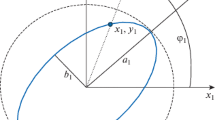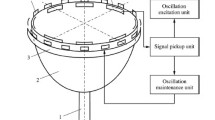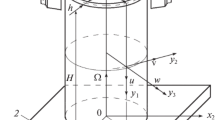Abstract—
The fundamentals of the theory of new gyroscopic sensors of the “generalized” Foucault pendulum series, which are implemented on the basis of a multimode elastic axisymmetric high-Q resonator, i.e., a hemispherical resonator gyroscope (HRG), are described. On the edge of a hemispherical quartz resonator of such an inertial sensor, multiple operational wave forms (modes) of mechanical standing waves of elastic vibrations can simultaneously be excited and exist. It should be noted that when several modes (forms) of vibrations of an axisymmetric resonator are excited simultaneously, multiple independent channels of duplicated inertial information of the gyroscope orientation in space are created. The physical effect underlying the functioning of such sensors included in the considered class of free gyroscopes is described. The application aspects of implementation of the fundamental theory of a new “generalized” uncontrolled Foucault pendulum in high-precision inertial orientation sensors operating simultaneously with two operating modes of elastic vibrations are presented. It is shown that to implement a new way of functioning of a two-mode “generalized” uncontrolled Foucault pendulum in each design of the new HRG, it is necessary to provide excitation and sufficiently accurate acquisition of primary information on the nodes and antinodes of the two main operational modes (forms) of vibration of the gyroscope resonator edge.



Similar content being viewed by others
REFERENCES
V. F. Zhuravlev and D. M. Klimov, Wave Solid-State Gyroscopes (Nauka, Moscow, 1985) [in Russian].
V. F. Zhuravlev and D. M. Klimov, “Dynamic effects in an elastic rotating ring,” Mech. Solids 18 (5), 15–21 (1983).
G. Bryan, “On the beats in the vibrations of a revolving cylinder or bell,” Proc. Camb. Philos. Soc. 2, 101–111 (1890).
E. J. Loper, Jr. and D. D. Lynch, US Patent No. 2157041 (5 June, 1979).
V. F. Zhuravlev, “Theoretical foundations of wave solid gyroscope (WSG),” Mech. Solids 28 (3), 3–15 (1993).
D. D. Lynch, “Vibrating gyro analysis by method of averaging,” in Proc. 2nd Saint-Petersburg Int. Conf. on Gyroscopic Technology and Navigation (St. Petersburg, 1995), pp. 26–34
L. Foucault, “Demonstration physique du mouvement de la Terre au moyen du pendule,” C.R. Acad. Sci. 32, 135–138 (1851).
H. Kamerlingh Onnes, PhD Thesis (Groningen, 1879).
W. H. Quick, “Theory of vibrating string as an angular motion sensor,” Trans. ASME. Ser. E. J. Appl. Mech. 31 (3), 523–534 (1964).
J. C. Stiles, US Patent No. 3924475 (9 December, 1975).
E. J. Loper and D. D. Lynch, “Sonic gyro fabrication and testing,” Delco Electronics Division Rep. (Aug. 1977), No. R77–64.
E. J. Loper and D. D. Lynch, US Patent No. 4157041 (1979).
E. J. Loper and D. D. Lynch, “The HRG: a new low-noise inertial rotation sensor,” in Proc. 16th Joint Services Data Exchange for Inertial Systems (Los Angeles, 1982).
E. J. Loper and D. D. Lynch, “Lynch projected system performance based on recent HRG test results,” in Proc. 5th IEEE/AIAA Digital Avionics Systems Conf. (Seattle, 1983), No. S83–105.
E. J. Loper and D. D. Lynch, Patent EU 0141621 A2 (1984).
J. S. Burdess, “The dynamics of a thin piezoelectric cylinder gyroscope,” Proc. Inst. Mech. Eng., Part C 200 (4), 271–280 (1986).
M. G. Koning, US Patent No. 4793195 (1988).
C. H. Fox, “Vibrating cylinder rate gyro, theory of operation and error analysis,” in DGON Symp. Gyro Technology (Stuttgart, 1988).
W. B. Scott, “Delco makes low-cost gyro prototype,” Aviat. Week Space Technol. 117 (17), 64–72 (1982).
P. Leger, “Quapason – a new low-cost vibrating gyroscope,” in Proc. 3rd St.-Petersburg Int. Conf. on Integrated Navigation Systems (St. Petersburg, 1996), Pt. 1, pp. 143–149.
V. Ph. Zhuravlev and S. E. Perelyaev, “The generalized Foucault pendulum is a 3d integrating gyroscopes using the three-dimensional precession of standing waves in a rotating spherically symmetric elastic solid,” in Proc. Inertial Sensors&Systems ISS 2019 (Braunschweig, 2019).
A. Yu. Ishlinskii, Orientation, Gyroscopes and Inertial Navigation (Nauka, Moscow, 1976) [in Russian].
V. F. Zhuravlev, “Fundamental questions of the theory of new gyroscopic sensors of the “generalized Foucault pendulum” family,” in Problems of Mechanics: Collection of Articles. Dedicated to the 90th Anniversary of A. Yu. Ishlinskii, Ed. by D. M. Klimov (Fizmazlit, Moscow, 2003) [in Russian].
B. Friedland and M. F. Hutton, “Theory and error analysis of vibrating-member gyroscope,” IEEE Trans. Autom. Control AC–23 (4), 545–556 (1978).
S. E. Perelyaev, B. P. Bodunov, and S. B. Bodunov, “Solid-state wave gyroscope: a new-generation inertial sensor,” in Proc. 24th St. Petersburg Int. Conf. on Integrated Navigation Systems, ICINS 2017 (State Research Center of the Russian Federation Concern CSRI “Elektopribor”, St. Petersburg, 2017), pp. 287–290 [in Russian].
V. F. Zhuravlev, S. E. Perelyaev, B. P. Bodunov, and S. B. Bodunov, “New-generation small-size solid-state wave gyroscope for strapdown inertial navigation systems of unmanned aerial vehicle,” in Proc. 26th St. Petersburg Int. Conf. on Integrated Navigation Systems, ICINS 2019 (State Research Center of the Russian Federation Concern CSRI “Elektopribor”, St. Petersburg, 2019) [in Russian].
Author information
Authors and Affiliations
Corresponding author
Additional information
Translated by N. Petrov
About this article
Cite this article
Perelyayev, S.E. Theory of New Gyroscopic Sensors of the “Generalized” Foucault Pendulum Series Operating in Two Modes. Mech. Solids 56, 1611–1621 (2021). https://doi.org/10.3103/S0025654421080161
Received:
Revised:
Accepted:
Published:
Issue Date:
DOI: https://doi.org/10.3103/S0025654421080161




